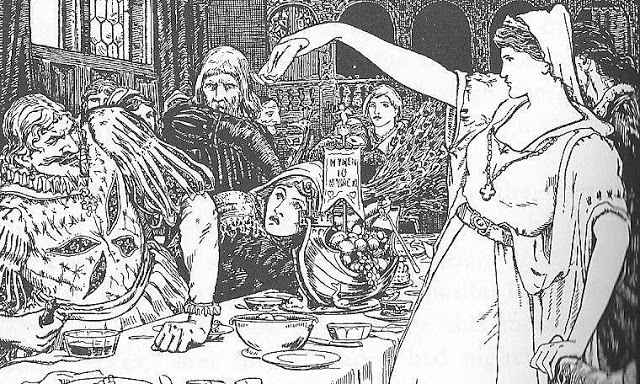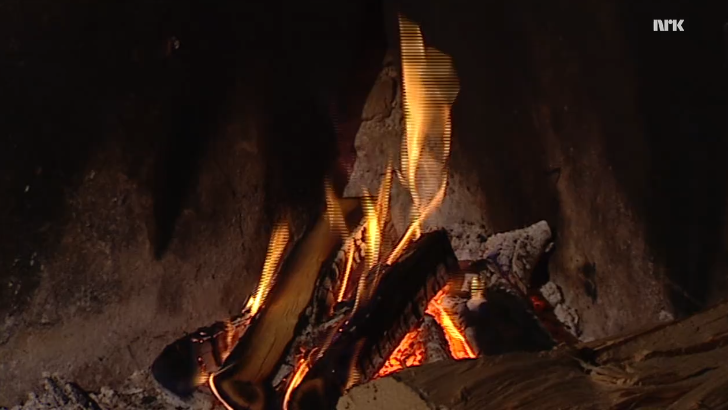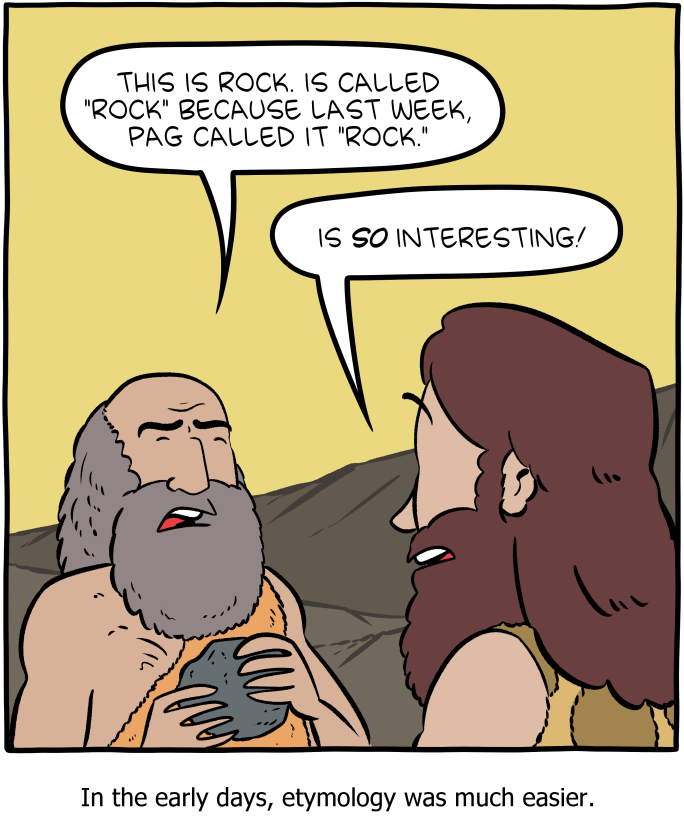English has a lot of words relating to fire, including fairly specialized ones like pyre – a funeral fire for cremation. The same root is also found in words like pyro-maniac or pyro-technics, where it more obviously just means ‘fire’. If you’ve got Grimm’s law in mind, you might guess that fire and pyr- are somehow connected. And you’d be right. Fire is the more direct Germanic word, while pyr- is borrowed from Greek (which is why it escapes Grimm’s fricativizing influence).

English also has other roots related to fire, including the Latin-derived element found in words like ignite or igneous (rock). Although these words are a bit specialized in English, they come a word that was very common and basic in Latin: ignis ‘fire’. This word doesn’t look much at all like either fire or pyr-, and indeed it represents an etymologically distinct word-family.
How did Greek and Latin, both older Indo-European languages, come to have such different words for ‘fire’? Actually discrepancies of this sort are extremely common, for all sorts of reasons, even among very closely related languages. Languages are constantly shifting around the meanings of words, deriving new formations from existing elements, or borrowing words from other languages, or sometimes even inventing words ex nihilo: vocabulary shift is a normal and natural part of language – and fortunately so, since such changes often provide interesting clues for linguistic historians to pick up on.
In this particular case, the interesting clue is that both ignis and fire seem to go back to Proto-Indo-European. Aside from English fire and Greek pũr, there are words like Armenian howr (with a shift of *p- to h-), Umbrian pir, Tocharian B puwar, and Hittite paḫḫur, which all point to an Indo-European word along the lines of *peh₂wr̥ (in what’s often thought to have been its oldest reconstructible form). On the other hand, ignis is cognate with Old Church Slavonic ognĭ (this was a medieval Slavic language widely used for liturgical purposes), Lithuanian ugnis (this is a Baltic language), and Sanskrit agniḥ. These go back to something like *n̥gnis.
So Proto-Indo-European seems to have already had two words for fire. In most later languages, only one has stuck around, though in some cases, like the Italic branch, they must have coexisted for a long time: while Latin has ignis, its fairly close relative Umbrian (now long extinct, displaced by Latin’s massive spread) attests the word pir.
The two words were probably not exactly synonyms. They both referred to fire, but in a different way. Sanskrit agniḥ, for instance, is not just used for fire, but also for personified and deified fire, the god Agni. In Indo-European, *n̥gnis seems to have meant ‘fire’ in a more active, animate sense. By contrast, *péh₂wr̥ apparently referred to fire in less personal, more inanimate way.
 Agni. Personified fire apparently likes to ride a ram?
Agni. Personified fire apparently likes to ride a ram?
This difference isn’t just one of meaning, but was encoded in a very important aspect of Indo-European grammar: gender. If you’ve ever studied a language like Spanish or German, you’ll be used to the idea that every noun is arbitrarily assigned to one of two (for Spanish) or three (for German) classes, usually given the rather anthropomorphic labels of masculine, feminine, and (as the potential third) neuter. So, for example, where in English we use the single pronoun it for basically all non-human (or non-animal) things, in German you would use the equivalent of it (es) for neuter nouns, but for a masculine noun you’d use the equivalent of he (German er), and for a feminine noun you’d use the equivalent of she (sie). So of a book (neuter), you could say ‘it is on the table’, for a shoe (a masculine noun) you’d say, in effect, ‘he’s on the table’ (why is your shoe on the table?). Similarly, for a feminine noun, like hand, you’d say the equivalent of ‘she’s on the table’. There’s a bit more to grammatical gender than this, but the fundamental idea is that every noun has a gender, and this determines how other words, like pronouns (but also adjectives and the like), interact with the noun.
 The hand that Lady Mary is holding was grammatically feminine in older English.
The hand that Lady Mary is holding was grammatically feminine in older English.
(If you don't know the story Mr. Fox, go read it now.)
Most of the older Indo-European languages show the three-gender system, like German. We know that Spanish used to have three genders as well, since we can see this in Latin – the neuter gender was lost at a pretty early stage in the development of the Romance languages from Latin. It was clearly an important part of Indo-European grammar. But interestingly, the Anatolian languages such as Hittite show a different system: instead of the trinity of masculine/feminine/neuter, they show only two classes. Not masculine and feminine, like Spanish, but animate and inanimate. This was very interesting, not least because even before Hittite was discovered, scholars had proposed that the three classic genders of Indo-European might actually have grown out from exactly this kind of animacy distinction.
The basic idea is this: at an early stage, in Proto-Indo-European proper, there were just two genders. Every noun was classified as either animate (like *n̥gnis, the living, god-like fire) or else as inanimate (like *péh₂wr̥, the more everyday, mundane fire). This is still what Hittite shows in general (though form of *n̥gnis isn't attested in the surviving texts). But most of the other Indo-European languages underwent an innovation, splitting the animate nouns into two groups: some became masculine, others feminine; *n̥gnis happened to go the masculine route, and all the later forms I cited, like Latin ignis and Sanskrit agniḥ, are masculine nouns. On the other hand, inanimate nouns went into the neuter basket, and all the various forms from *péh₂wr̥ (down to and including Feuer in modern German) are neuter.
 Germanic fires are inanimate (grammatically).
Germanic fires are inanimate (grammatically).
This story (which I’ve simplified a bit) is interesting for a few reasons. One is that animacy in general is a fun and fascinating linguistic topic. Animacy distinctions are actually not uncommon in languages around the world – many American languages in particular are famous for their animacy systems. But exactly how animacy can work varies a lot from language to language, often in highly arbitray ways. The basic idea is that ‘animate’ roughly means ‘more human-like’, but there are many variations on that theme, as the Indo-European distinction between animate and inanimate fires shows (we can also reconstruct a comparable distinction for water as well). Even in English, animacy continues to play a role, if considerably attenuated: it, historically a neuter pronoun in the three-gender system, remains steadfastly inanimate. There is a reason why they is widely preferred as a gender-neutral singular pronoun rather than it, since the use of the latter is seen as dehumanizing, denying the referent the status of a fully animate human.
Another reason to take note of animacy is to highlight that the reconstruction of Indo-European isn’t reaching back to a single primordial state, but involves dynamic changes over time. We do make our best effort to reconstruct ‘Proto-Indo-European’ proper, as the state of the language actually common to all recorded Indo-European languages, but this is just a starting point. There were a lot of very early changes with significant effects on the structure of early Indo-European, which form a vital part of the early history of all Indo-European languages. In this series, I won’t be able to even mention all of the major changes of this sort that took place, so I’ll leave the animacy/gender development as a typical example of very early grammatical change in Indo-European.
Further Reading
I've given the oldest form of fire as *péh₂wr̥ (or *páh₂wr̥, with laryngeal colouring), but it's worth mentioning that the word had some important alternations in its inflection, only some of the Anatolian forms (like Hittite paḫḫur) come more or less directly from this. Other forms, including fire itself, involve more elaborate morphological changes, not just sound changes. See NIL, pages 540-545, and especially the lengthy note 1 there, for the full panoply of forms and the apparatus proposed to reconcile the many variants. (The etymon of ignis is also controversial, with people varying in whether the word starts with a laryngeal, whether the rest of the first syllable is *eg-/og- or *n̥g-, and whether the *g should actually be *gʷ.)
When it comes to picking apart the exact semantics of word pairs like the animate and inanimate fire-words, there's been a lot of debate about just how we should understand each term. For one plausible take, there's a classic article by Antoine Meillet (one of the giants of Indo-European philology in his day) that's still worth reading.
The development of the gender system more broadly is at least touched on in pretty much all of the various introductions to and overviews of Indo-European that I've mentioned over the last bunch of posts. Things get extra tricky/interesting when we get to arguments that connect the early animate-inanimate system in nouns to the reconstruction of the early verbal system.
I've avoided getting into the verbs too much in this series, since it's a hard topic to reduce down into manageable chunks in this format -- it's a big topic, with a lot of interconnected parts, and there are some very sharply differing hypotheses on many important points. In particular, one feature of inanimate/neuter nouns in Indo-European is that they always have the same form for the nominative case (the 'subject' case) and the accusative (the 'direct object' case). This has been linked to the idea that Proto-Indo-European might have originally not been based around the nominative-accusative distinction, but rather around something else, possibly an ergative system. Under such a system, subjects of transitive verbs receive special marking (are 'ergative'), while there is a single kind of marking used for both the subjects of intransitive verbs, as well as for the objects of transitive verbs (together called the 'absolutive' category). An ergative hypothesis for Proto-Indo-European would basically suggest that inanimate nouns were less prototypically subjects of transitive verbs, and so when the whole system shifted to have nominative and accusative cases instead of ergative and absolutive, inanimates just used the absolutive form for both the new nominative and new accusative. Animate nouns, on the other hand, more frequently showed ergative forms, and turned those into the new nominative, and used the absolutive form for the new accusative.
For an extensive, and much, much more nuanced argument in favour of an ergative Proto-Indo-European, see Andreas Willi's recent book Origins of the Greek Verb (which, despite the name, ventures as deeply as anything into the earliest forms of the Indo-European verbal system). If you want a nice clear overview of just what these arguments are all about, section 6.4 of Clackson's Indo-European Linguistics (which I've mentioned before) is a good place to start. For a somewhat different approach, preferring an 'active-stative' or a 'split-S' system, chapter 10 of Lehmann's book The Theoretical Bases of Indo-European Linguistics (recommended in the previous post) is a good place to start, though much else has been written on the topic since.
The process of how the animate split into two genders, masculine and feminine, has been discussed a very great deal. A recent edited collection with a number of relevant papers is Studies on the Collective and Feminine in Indo-European from a Diachronic and Typological Perspective (edited by Sergio Neri and Roland Schuhmann). As the title of that book indicates, there are some further wrinkles I haven't had a chance to touch on in this post: a possible connection between the feminine gender and 'collective' formations, which in turn are potentially connected with the 'plurals' of neuter/inanimate nouns. That is to say, there may have been more going on than a simple split of the animate gender into two new categories!
On animacy more generally, a good place to start is Marianne Mithun's section on gender (pages 95-103) in The Languages of Native North America. For an accessible picture of animacy structures in the Algonquian family (which are particularly well-developed and well-known), I found this paper by Will Oxford very useful (though there might well be better places to start out there). For a more global discussion of linguistic animacy, an important book is Animacy and Reference by Mutsumi Yamamoto. A foundational article proposing the influential idea of an 'animacy hierarchy' is Michael Silverstein's 'Hierarchies of features and ergativity' (1976, in this edited volume).
One final thing: grammatical gender is not social gender. The Indo-European system does tend to lead to a broad correlation between the two, but it's often a little fuzzy, and often totally irrelevant (that book is grammatically feminine in Old English has no 'meaning' at all).



